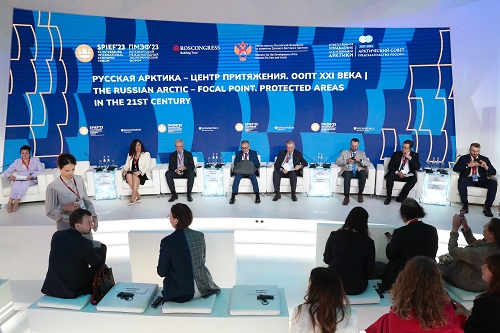Russia | India
Conservation of ecological systems in the Arctic and the prospects for developing specially protected natural areas were discussed at the session “The Russian Arctic – Focal point. Protected Areas in the 21st Century” held during the St. Petersburg International Economic Forum. The event was part of Russias chairmanship of the Arctic Council in 2021-2023, the operator of the chairmanship events being the Roscongress Foundation.
Sustainable Development of Protected Arctic Areas Discussed at SPIEF 2023
“It is important to develop a comprehensive line of action for integrating economic operators, their responsible ESG practices and the role of the regions. If we really do build such a concept, we will be able to ensure truly sustainable development of the Arctic region, balancing the economic, environmental and social agenda. It is also crucial to provide for international cooperation in this area,” said Nikolay Korchunov, Ambassador-at-Large of the Ministry of Foreign Affairs of the Russian Federation and Chair of the Senior Arctic Officials.
He pointed to the unique role of Russia’s Arctic regions in conserving biodiversity across the Arctic, hoping that the SPIEF session would trigger broader discussion of regional efforts to conserve biodiversity with a view to sharing best practices and recommendations for collaboration with economic operators.
“We talk a lot about economic development, which is, indeed crucial for success. But every effort must be made to find a balance between economic development and biodiversity conservation. Practices already developed and proven to be effective, such as in the Murmansk Region, must be rolled out to neighbouring regions. It is also vital to study global tourism development practices: the maximum recreational capacity and permissible recreational load for a territory must be calculated,” emphasized Vyacheslav Fetisov, State Duma Deputy and UN Goodwill Ambassador for Russia.
Irina Makanova, Director of State Policy and Regulation Department for Development of Specially Protected Natural Areas in the Ministry of Natural Resources and Environment of the Russian Federation, pinpointed transport accessibility, elimination of accumulated damage, and recruitment of new staff into the industry as the key challenges for further developing protected areas in the Arctic.
“Since 2018, when the ‘Conservation of Biodiversity and Development of Ecotourism’ federal project was adopted as part of the Ecology national project following the Presidential Decree ‘On Strategic Goals and Targets in the Arctic’, we have established three specially protected natural areas covering around 10 million hectares. Today, the forty protected areas in the Arctic account for half of all federal protected areas, representing the most effective mechanism for conserving Arctic biodiversity,”Makanova explained.
Also participating in the session were Dmitry Artyukhov, Governor of the Yamalo-Nenets Autonomous District, Olga Kuznetsova, Deputy Governor of the Murmansk Region, Andrey Grachev, Vice-President for Federal and Regional Programmes at Norilsk Nickel, Alexander Kirilov, Director of the Russian Arctic National Park, Bogdan Bulychev, traveller, blogger and producer, and Glenn Diesen, Professor at the University of South-Eastern Norway.
The session “The Russian Arctic – Focal point. Protected Areas in the 21st Century” was held at the stand of the Russian Ministry for the Development of the Far East and the Arctic during the SPIEF. The stand’s business programme featured around 15 events, some being held as part of Russia’s Chairmanship of the Arctic Council. These include the discussions “The Northern Sea Route. Outcomes and Plans”, “Protecting and Monitoring Arctic Biodiversity” and “Film-Making in the Arctic: Dialogue Between Nature and Technology.”



